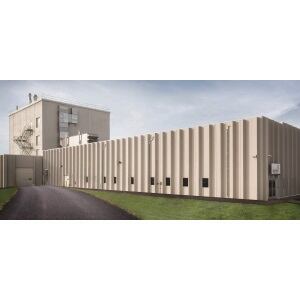“We’ve adopted very tight quality practices from exceptionally hygienic industries that have not been seen in the grain industry, and have drawn on our long experience in Canada and with our customers to create the most food-safe grain processing plant in existence,” Verhasselt told us.
Keeping the inside totally separate from the outside world
A significant amount of planning went into the development of the Next Generation Grain processing facility (pictured, right), which largely involved finding innovative ways to effectively keep what’s outside out and what’s inside in.

“During the planning and build, we made sure to go beyond the Food Safety Modernization Act requirements, to set new standards for food safety in grain processing facilities,” Verhasselt said. “The plant accepts and handles only 99.9% pure, food-grade raw material, supported by a series of mandated quality checks and balances to ensure the quality and stability of the finished ingredients. We’ve taken many steps to ensure that pests and contaminants just simply can’t get in.”
For example, the facility uses slip-form concrete construction to all but eliminate pest or rodent entry points. The plant also uses MERV 15 filtered positive pressured air to eliminate outside air from entering the building, while special segregation zones ensure additional food safety and quality control through positive pressure HEPA filtered air.
Moreover, the facility stipulates specific entry criteria, which include finger scan technology for entry authorization into secure areas, dedicated uniforms and footwear, and cleaning tools kept exclusively within rooms to reduce any chance of cross contamination. The facility is also designed with distinct areas for deliveries and shipping, “keeping the inside environment entirely separate from the outside world,” Verhasselt added, quipping: “and that’s just a start of what makes this facility special.”
Maintaining integrity in delicate ingredients
The plant currently produces MeadowPure flaxseed ingredients, along with a growing portfolio of chia, quinoa and other ancient grain ingredients, though Verhasselt wouldn’t specify further.
The patented MeadowPure process of sourcing, sorting and milling ingredients protects flaxseed’s omega-3 fatty acids by “removing inferior quality and stressed flaxseeds, which are proven to trigger oxidation and ultimately degrade flavor and aroma,” he said. “The cleaning process also preserves the nutrition and flavor of finished products, ensuring more stable, better-tasting food applications.”
Moreover, the MicroSure Plus 5-log validated heat treatment process also maintains food safety, stability and consistency in a range of products, with support from the plant’s on-site laboratory, which performs inline, real-time product quality testing and monitoring.
Not just about production speed and volumes
Despite the “significant grain processing power” of the 63,000 sq. ft. site, Verhasselt noted that plant is not just about capacity and production speed. “We also are laser-focused on food safety,” he said.
The Safe Quality Food (SQF) 2000 certified facility is a fully enclosed site with closed-loop processing to eliminate any foreign material or contaminants from entering the building or process. In line with this, grain handling is entirely internal, with no external grain unloading or grain bin storage, which dramatically reduces the risk of exposure of raw material to potential contaminants.
